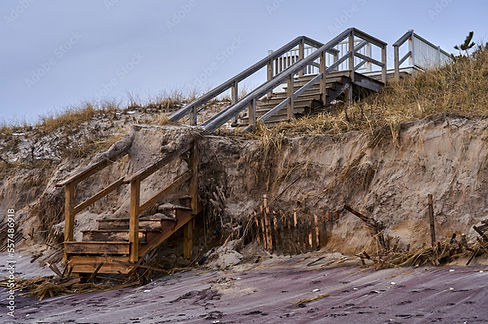COASTAL RESILIENCY
What is coastal resilience?
Providing infrastructure for a community to “bounce back” after hazardous events such as hurricanes, coastal storms, and flooding. Suffolk’s resilience is based on our ability to prevent a short-term hazard event from turning into a long-term community-wide disaster. Our coasts are vulnerable to sea-level rise and heavy storms that can result in flooding.

Post-Sandy
Coastline Damage
In 2012, Hurricane Sandy hit Long Island and over 100,000 homes were deemed severely damaged or destroyed, with another 2,000 deemed uninhabitable. The primary causes of this damage, according to NOAA, were waves and storm surge. Devastation from Superstorm Sandy and the risks posed by climate change and sea-level rise justify bold and continuing actions to dramatically improve coastal resiliency in Suffolk County. Poor water quality, especially from nitrogen pollution, has reached a near-crisis point in many coastal areas of Long Island. Peer-reviewed science has demonstrated a connection between excess nitrogen pollution and the degradation of the coastal marshland complexes that help protect Long Island’s south shore population centers from storm inundation.

How Will
Sewers Help?
The most effective solution for nitrogen pollution in high-density communities relying on individual disposal systems is the installation of sewage collection and treatment systems. Suffolk County has proposed technically sound, large-scale projects to extend sewers in various areas to address nitrogen and pathogen pollution affecting local waterways.
These efforts are critical first steps in a comprehensive initiative to improve water quality, protect shellfish beds, restore seagrass, and enhance the resilience of marshlands. By reducing nitrogen pollution, these projects aim to safeguard both environmental health and coastal ecosystems across the region.

Reasons Why
Outdated Septic Tanks are Poorly Affecting our Environment
Many of the on-site systems in established communities are more than 40 years old, and as systems have aged, failure rates have increased dramatically, especially in the case where high groundwater conditions exist. As a result of the aging infrastructure issues including the decline in quality of drinking water, loss of wetlands, harmful algae blooms, and further impairing water bodies have increased.
Approximately seventy percent of Suffolk County's 1.5 million residents have an on-site sanitary wastewater treatment and disposal system. These systems are comprised of a septic tank or cesspool for solids, connected to leaching pools to allow clarified water to seep into the ground. Many of the on-site systems in established communities are more than 40 years old, and as systems have aged, failure rates have increased dramatically, especially in the case where high groundwater conditions exist. As a result of the aging infrastructure and the effects of Hurricane Sandy, the Suffolk County Comprehensive Water Resources Management plan found the following:
-
Gradual decline in quality of drinking water
-
Negative trends in quality of drinking water
-
Harmful algal blooms and Brown Tides attributed to excessive nutrient loads
-
Loss of wetlands is leading to a depleted coastal resiliency
-
Nitrification, impaired water bodies, impaired rivers, closed beaches, and devastation of the shellfish industry

